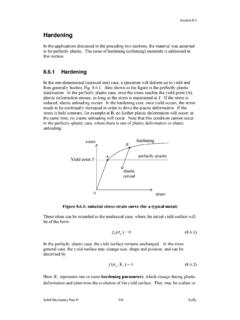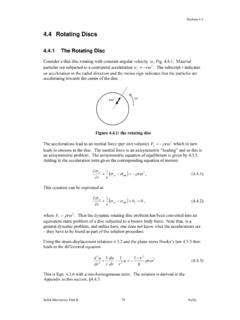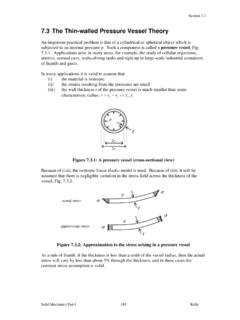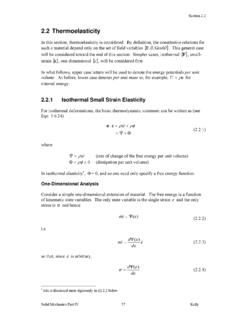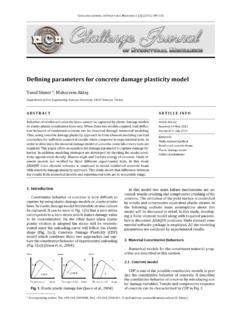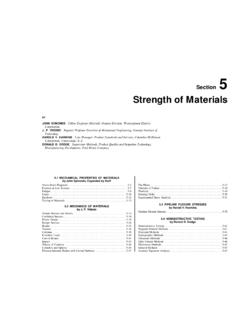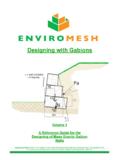Transcription of 8.3 Yield Criteria in Three Dimensional Plasticity
1 Section Solid Mechanics Part II Kelly Yield Criteria in Three Dimensional Plasticity The question now arises: a material yields at a stress level Y in a uniaxial tension test, but when does it Yield when subjected to a complex Three - Dimensional stress state? Let us begin with a very general case: an anisotropic material with different Yield strengths in different directions. For example, consider the material shown in Fig. This is a composite material with long fibres along the 1x direction, giving it extra strength in that direction it will Yield at a higher tension when pulled in the 1x direction than when pulled in other directions. Figure : an anisotropic material; (a) microstructural detail, (b) continuum model We can assume that Yield will occur at a particle when some combination of the stress components reaches some critical value, say when kF ),,,,,(332322131211.
2 ( ) Here, F is some function of the 6 independent components of the stress tensor and k is some material property which can be determined experimentally1. Alternatively, it is very convenient to express Yield Criteria in terms of principal stresses. Let us suppose that we know the principal stresses everywhere, 123(, , ) , Fig. Yield must depend somehow on the microstructure on the orientation of the axes 123,,xxx, but this information is not contained in the Three numbers 123(, , ) . Thus we express the Yield criterion in terms of principal stresses in the form kFi ),,,(321n ( ) 1 F will no doubt also contain other parameters which need to be determined experimentally 1x)a()b(binder fibre bundles 1 2 2x1x2x3xSection Solid Mechanics Part II Kelly 260where in represent the principal directions these give the orientation of the principal stresses relative to the material directions 123,,xxx.
3 If the material is isotropic, the response is independent of any material direction independent of any direction the stress acts in, and so the Yield criterion can be expressed in the simple form kF ),,(321 ( ) Further, since it should not matter which direction is labelled 1 , which 2 and which 3 , F must be a symmetric function of the Three principal stresses. Alternatively, since the Three principal invariants of stress are independent of material orientation, one can write kIIIF ),,(321 ( ) or, more usually, kJJIF ),,(321 ( ) where 32,JJ are the non-zero principal invariants of the deviatoric stress. With the further restriction that the Yield stress is independent of the hydrostatic stress, one has kJJF ),(32 ( ) The Tresca and Von Mises Yield Conditions The two most commonly used and successful Yield Criteria for isotropic metallic materials are the Tresca and Von Mises Criteria .
4 The Tresca Yield Condition The Tresca Yield criterion states that a material will Yield if the maximum shear stress reaches some critical value, that is, Eqn. takes the form k 13322121,21,21max ( ) The value of k can be obtained from a simple experiment. For example, in a tension test, 0,3201 , and failure occurs when 0 reaches Y, the Yield stress in tension. It follows that 2Yk . ( ) Section Solid Mechanics Part II Kelly 261In a shear test, 321,0,, and failure occurs when reaches Y , the Yield stress of a material in pure shear, so that Yk . The Von Mises Yield Condition The Von Mises criterion states that Yield occurs when the principal stresses satisfy the relation k 6213232221 ( ) Again, from a uniaxial tension test, one finds that the k in Eqn. is 3Yk.
5 ( ) Writing the Von Mises condition in terms of Y, one has Y 21323222121 ( ) The quantity on the left is called the Von Mises Stress, sometimes denoted by VM . When it reaches the Yield stress in pure tension, the material begins to deform plastically. In the shear test, one again finds that Yk , the Yield stress in pure shear. Sometimes it is preferable to work with arbitrary stress components; for this purpose, the Von Mises condition can be expressed as { Problem 2} 223122321221133233222221166k ( ) The piecewise linear nature of the Tresca Yield condition is sometimes a theoretical advantage over the quadratic Mises condition. However, the fact that in many problems one often does not know which principal stress is the maximum and which is the minimum causes difficulties when working with the Tresca criterion. The Tresca and Von Mises Yield Criteria in terms of Invariants From Eqn.
6 And , the Von Mises criterion can be expressed as 0)(222 kJJf ( ) Note the relationship between 2J and the octahedral shear stress, Eqn. ; the Von Mises criterion can be interpreted as predicting Yield when the octahedral shear stress reaches a critical value. With 321 , the Tresca condition can be expressed as Section Solid Mechanics Part II Kelly 262 0649636274),(624222233232 kJkJkJJJJf ( ) but this expression is too cumbersome to be of much use. Experiments of Taylor and Quinney In order to test whether the Von Mises or Tresca Criteria best modelled the real behaviour of metals, G I Taylor & Quinney (1931), in a series of classic experiments, subjected a number of thin-walled cylinders made of copper and steel to combined tension and torsion, Fig. Figure : combined tension and torsion of a thin-walled tube The cylinder wall is in a state of plane stress, with 11 12 and all other stress components zero.
7 The principal stresses corresponding to such a stress-state are (zero and) { Problem 3} 224121 ( ) and so Tresca's condition reduces to 22244k or 12/22 YY ( ) The Mises condition reduces to { Problem 4} 22233k or 13/22 YY ( ) Thus both models predict an elliptical Yield locus in , stress space, but with different ratios of principal axes, Fig. The origin in Fig. corresponds to an unstressed state. The horizontal axes refer to uniaxial tension in the absence of shear, whereas the vertical axis refers to pure torsion in the absence of tension. When there is a combination of and , one is off-axes. If the combination remains inside the Yield locus, the material remains elastic; if the combination is such that one reaches anywhere along the locus, then Plasticity ensues. Section Solid Mechanics Part II Kelly 263 Figure : the Yield locus for a thin-walled tube in combined tension and torsion Taylor and Quinney, by varying the amount of tension and torsion, found that their measurements were closer to the Mises ellipse than the Tresca locus, a result which has been repeatedly confirmed by other workers2.
8 2D Principal Stress Space Fig. gives a geometric interpretation of the Tresca and Von Mises Yield Criteria in , space. It is more usual to interpret Yield Criteria geometrically in a principal stress space. The Taylor and Quinney tests are an example of plane stress, where one principal stress is zero. Following the convention for plane stress, label now the two non-zero principal stresses 1 and 2 , so that 03 (even if it is not the minimum principal stress). The Criteria can then be displayed in 21, 2D principal stress space. With 03 , one has Tresca: Y 1221,,max ( ) Von Mises: 2222121Y These are plotted in Fig. The Tresca criterion is a hexagon. The Von Mises criterion is an ellipse with axes inclined at 045 to the principal axes, which can be seen by expressing Eqn. in the canonical form for an ellipse: 2 the maximum difference between the predicted stresses from the two Criteria is about 15%.
9 The two Criteria can therefore be made to agree to within by choosing k to be half-way between 2/Y and 3/Y 3/YY 2/YY YMisesTrescaSection Solid Mechanics Part II Kelly 264 1221122 12211222221221221211/21/ 211/ 21/ 2 1/ 201/ 21/ 203/21/ 21/ 21/ 2 1/ 2132222122/3 YYY where 12, are coordinates along the new axes; the major axis is thus 2Y and the minor axis is 2/3Y. Some stress states are shown in the stress space: point A corresponds to a uniaxial tension, B to a equi-biaxial tension and C to a pure shear . Figure : Yield loci in 2D principal stress space Again, points inside these loci represent an elastic stress state. Any combination of principal stresses which push the point out to the Yield loci results in plastic deformation. Three Dimensional Principal Stress Space The 2D principal stress space has limited use.
10 For example, a stress state that might start out two Dimensional can develop into a fully Three Dimensional stress state as deformation proceeds. Y2 1 2 CAB EDY1 Section Solid Mechanics Part II Kelly 265In Three Dimensional principal stress space, one has a Yield surface 0,,321 f, Fig. 3. In this case, one can draw a line at equal angles to all Three principal stress axes, the space diagonal. Along the space diagonal 321 and so points on it are in a state of hydrostatic stress. Assume now, for the moment, that hydrostatic stress does not affect Yield and consider some arbitrary point A, cba,,,,321 , on the Yield surface, Fig. A pure hydrostatic stress h can be superimposed on this stress state without affecting Yield , so any other point hhhcba ,,,,321 will also be on the Yield surface. Examples of such points are shown at B, C and D, which are obtained from A by moving along a line parallel to the space diagonal.
